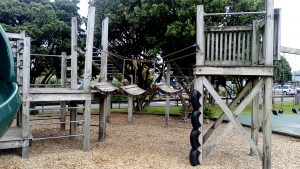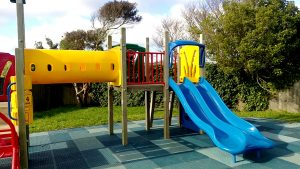03 Oct Development of an Evaluation Tool to Measure Accessibility and Usability of Parks and Playgrounds.
Urban parks and children’s playgrounds have the potential to provide a free environment to participate in social, leisure and physical activities for all ages. There is evidence that people who visit parks are more likely to meet recommended physical activity guidelines and report better physical, psychological and social well-being (Bedimo-Rung et al., 2005 and Sallis et al., 2016). But are they accessible and usable by people with disability?
In New Zealand, a quarter of the population report having a disability. This rises to over 65% in people over the age of 65 years. Research shows that people with disability are less likely to be physically active yet are at greater risk of poorer physical, psychological and social well being.
The research team wished to evaluate the accessibility and usability of parks and playgrounds. We could find no tool either nationally or internationally to evaluate accessibility.
In collaboration with Hutt, Porirua and Wellington city councils, CCS Disability Action and the New Zealand Blind Foundation we created an evaluation tool. To read more about the tool follow this link: Perry MA, et al., Accessibility and usability of parks and playgrounds, Disability and Health Journal (2017) . The tool evaluates the accessibility, usability and safety of (a) routes and (b) facilities and amenities. The accessible routes section includes: (i) accessible parking spaces and (ii) path surfaces. The facilities and amenities encompass: (i) play areas including play richness, (ii) rest areas (iii) toilets and (iv) drinking fountains.
We then randomly audited 21 parks in the Greater Wellington Region with this tool. No park met national nor international guidelines/standards for all aspects of park and playground design. For example, of the six parks that provided accessible car parking, all failed to meet either one or both dimensional recommendations (i.e. width of 3.5 m and length of 5 m). No playground had an accessible route to higher level play equipment. No park provided space adjacent to or alongside rest areas or picnic tables for including people in a wheelchair. Parks in lower socioeconomic areas were less accessible.
This tool provides a means of evaluating current parks and playgrounds. City Councils may use this tool to determine the accessibility and usability of their current parks and playgrounds. Read about Porirua City Council using the tool in its 41 Porirua playgrounds.
This enables councils to determine the extent of the issue and develop strategies and funding to ensure their parks and playgrounds are inclusive. People have different abilities and needs thus a universal design approach may be appropriate.
Our research highlights the need for legislation that requires park design to go further than the minimal standards to ensure that all people regardless of age or ability can access our parks and playground should they wish too. The ability to access parks and playgrounds, and participate, is a human rights issue. Ensuring that accessibility and usability are considered foremost in urban design, including park and playgrounds, is a public health issue that all health professionals should be cognisant of and advocating for at the local government level, especially as the population ages.

Figure 1.
In this image, you can see a boxed park with woodchips. Getting over the lip and across the woodchips creates an accessibility issue. There is no accessible route to the high play items and no play items at ground level. There is no contrasting colour to denote change in height or surface. This is an example of a typical playground environment that we evaluated.

Figure 2.
While there is side-by side option and contrasting colours between play items, there is not accessible route to the high play items or contrasting colour to denote change in surface height.
Authors: Meredith A Perry PhD, Hemakumar Devan PhD, Harry Fitzgerald BPhty, Karen Han BPhty, Lisa Liu BPhty, Jack Rouse BPhty.
Centre for Health, Activity and Rehabilitation Research (CHARR), School of Physiotherapy, University of Otago, Wellington, New Zealand
References:
Bedimo-Rung AL, Mowen AJ, Cohen DA. The significance of parks to physical activity and public health: A conceptual model. American Journal of Preventive Medicine. 2005;28(2):159-168.
Sallis JF, Cerin E, Conway TL, et al. Physical activity in relation to urban environments in 14 cities worldwide: A cross-sectional study. The Lancet. 2016;387(10034):2207-2217. 10.1016/s0140-6736(15)01284-
Article supplied by Dr Meredith Perry, October 2017
For further information contact: Dr Meredith Perry [email protected]

